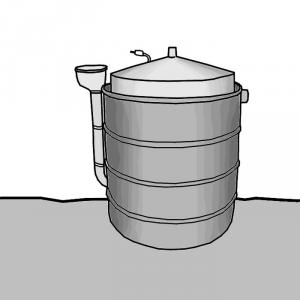Executive Summary
Anaerobic biogas digesters are airtight reactors in which organic waste is decomposed and transformed into biogas by a biological process called anaerobic digestion. Biogas is recovered and transformed into heat or any other form of energy. The remaining sludge contains many nutrients and can be used in agriculture (optionally after an aerobic post-composting). Mainly in industrialized countries, this technology has been evolved over the past centuries, resulting in various designs of different complexities. Facing the problem of municipal waste disposal and soaring fuel prices, low-tech set-ups, particularly adapted for developing countries have been developed today.
| In | Out |
|---|---|
Biogas, Compost/Biosolids, Fertigation Water |
Introduction
Biogas reactors are gastight chambers in which organic wastes are degraded and converted into biogas by microorganism in absence of air via a process called anaerobic digestion. The process lasts over a couple of weeks up to several months. Biogas is recovered and used either directly for cooking and lighting (at household level) or it is transformed into heat in a gas heater system or into combined heat and power (CHP) in cogeneration plants, thereby replacing other fuel sources (MES et al. 2003; JENSSEN et al. 2004; WRAPAI 2009). See also the factsheets about the conversion of biogas to electricity at small or large scale or the direct use of biogas factsheet. It can also be upgraded to natural gas quality, compressed and used to power motor vehicles. Nutrients remain in the sludge, which can be composted and used as soil amendment in agriculture. Liquid effluents are either treated and rejected, or reused in fertigation.
Anaerobic digestion is an established technology for the treatment of animal manure or wastewater (MES et al. 2003). In many industrialised countries, the conversion of municipal organic waste has become increasingly popular in recent years as a sustainable technology producing green energy. Consequently, various high-tech designs of different scales have evolved. In developing countries, many biogas support programmes have focused on rural families using animal manure and human faeces as feedstock in order to reduce the use of firewood by providing people with biogas, improve soil fertility and reduce indoor air pollution (VOEGELI & ZRUBRUEGG 2008). Today, facing the soaring challenge of municipal solid waste management in most urban areas in low and middle-income countries, anaerobic digestion is considered a promising option also for treatment of solid waste management in developing countries as well (www.eawag.ch; VOEGELI & ZURBRUEGG 2008; VOEGELI & LOHRI 2009). This factsheet presents the basic principals of anaerobic digestion as a treatment of solid waste and illustrates some of the many different technologies available today.
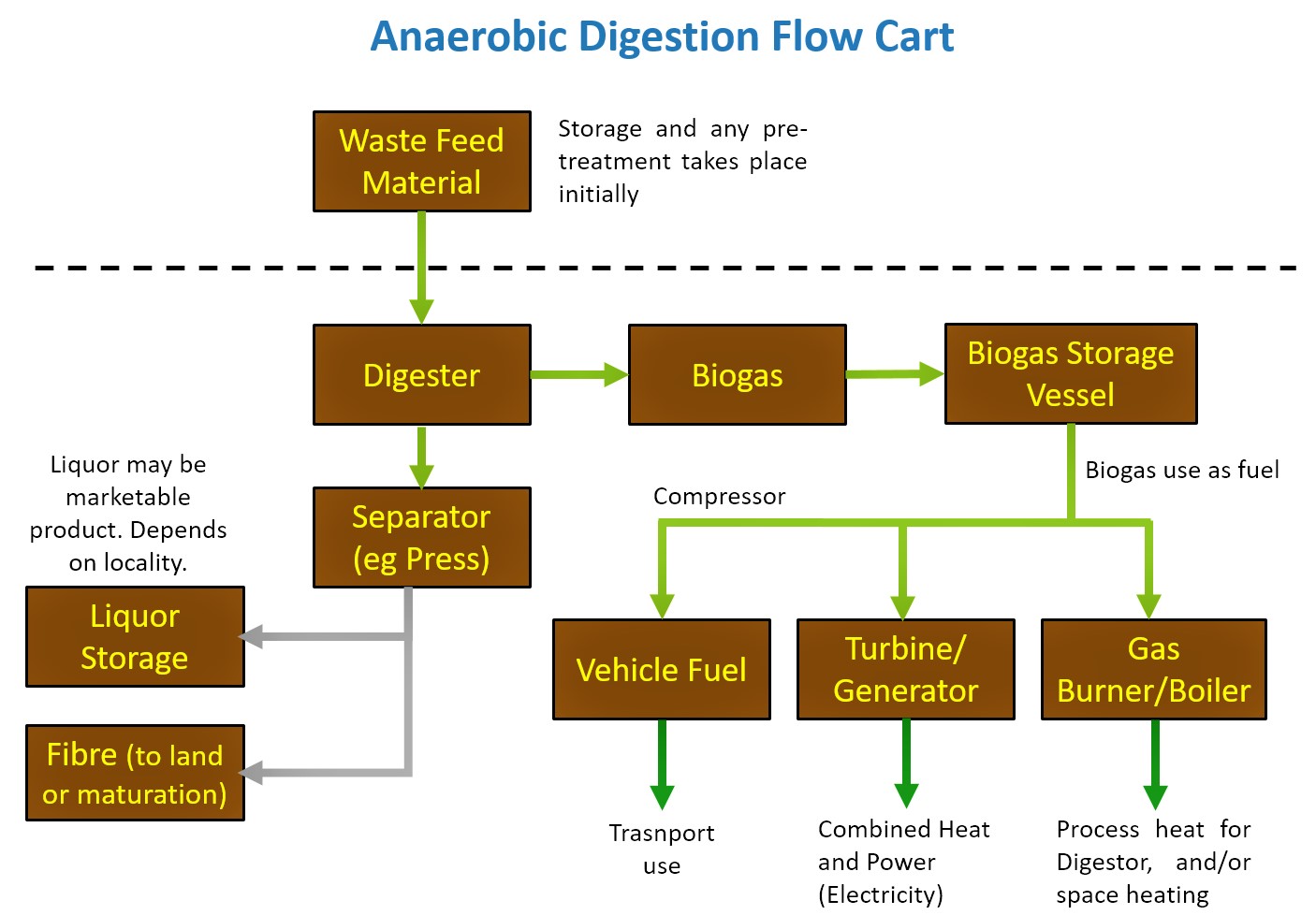
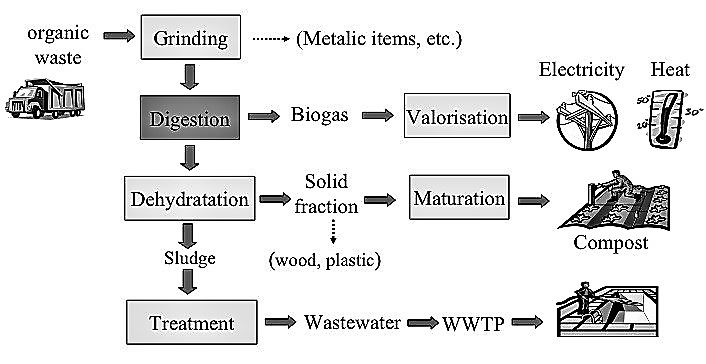
Process and design principles
All biogas digesters are basically designed following the same process of anaerobic digestion. Anaerobic digestion is a four-stage process consisting of hydrolysis; fermentation (conversion of non-soluble organic biomass to soluble organic compounds); acidification (e conversion of soluble organic compounds to volatile fatty acids and CO2, followed by the conversion of volatile fatty acids to acetate and H2); and finally methane formation. The final product, biogas, is a mixture of methane (CH4), carbon dioxide (CO2) and other trace gases (see also anaerobic digestion, general factsheet).
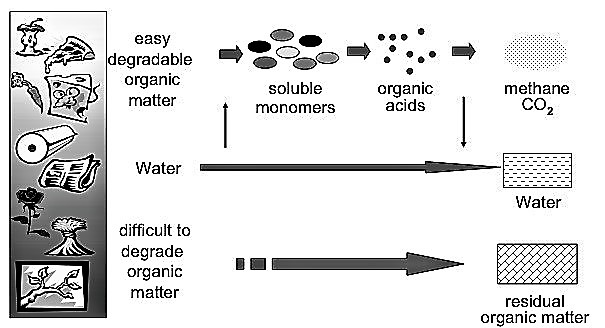
There are many ways in which anaerobic digestion can occur. The simplest reactors are covered waste dumps, where anaerobic digestion can occur naturally in uncontrolled systems. As mentioned above, today there is a large range of different types and designs of anaerobic digester technologies for the treatment of organic waste available. Even though the process for all these technologies is always the same (i.e. anaerobic digestion), depending on the composition of the substrate and the volume of the waste stream, complexity of design, construction and operation vary strongly.
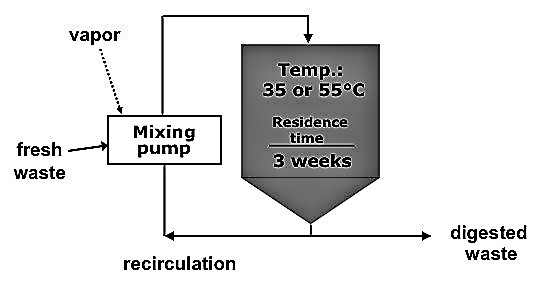
The main differences regarding the design of these technologies exist regarding the biogas potential of the substrate; dry and wet processes; mesophilic and thermophilic processes; mechanically mixed and no-mixed reactors, batch and continuous reactors and one-stage or multi-stage processes etc. In the following, a short overview on all these parameters is given (refer to anaerobic treatment, general factsheet).
Some reference values of biogas production potential of different substrates are given in the table below. The table also illustrates the potential of petrol equivalents saved. Conventional digesters apply a wet digestion process (total solids (TS) below 20%). Wet digestion has the advantage to provide good fluidity of the slurries and optimal contact of the microorganism and the waste. The new technology, dry digestion (TS > 20 %), allows high gas yields using less space, but the process has only recently been developed and is applied only at high-tech level. Mesophilic digestion is generally more stable even though gas yields are lower. Thermophilic processes produce more biogas in shorter time but require input energy and bear the risk of the production of toxic ammonia(ISAT/GTZ 1999 Vol. I). Batch systems are the lowest-tech of all systems and also the cheapest (VANDEVIVERE et al. 2002). Their major drawbacks are a large footprint and a lower biogas yield due to the impairment of the percolation process via channelling and clogging (VANDEVIVERE et al. 2002). Batch systems have a high potential for application in developing countries. Multi-stage processes separate the different stages of anaerobic digestion in order to achieve optimal growth conditions for the microorganism and to allow the heating of the methanogenic stage only (reducing required energy inputs). However, multi-stage systems are the most complex, and most expensive, of all systems biogas systems for solid waste (VANDEVIVERE et al. 2002).Low-tech small scale wet digesters generally do not provide any mechanical mixing as the gas bubbles rising through the sludge to the top of the reactor provide sufficient mixing. Large-scale, and in particular dry digestion processes require the installation of a mechanical stirring (or transporting device in the case of plug-flow reactors).
|
| Methane per ton (t) dry waste (m3/t) | Tons of petrol equivalents per ton of dry waste (t/t) |
| Food waste | 500 | 0.43 |
| Paper | 330 | 0.28 |
| Grass | 310 | 0.26 |
| Branches and leaves | 110 | 0.09 |
Energetic potential of municipal solid waste (MSW). Source: HOLLIGER (2008)
Most anaerobic digesters for the treatment of organic solid waste provide a post treatment of the remaining sludge before it can be reused as soil amendment in agriculture. Aerobic composting, the post-treatment used most often, allows both nitrification and the degradation of lignin, which is not possible under anaerobic conditions (HOLLIGER 2008).
Below, some examples of small-scale and large-scale anaerobic digesters for the treatment of organic solid wastes are given.
The ARTI compact biogas plant
ARTI stands for Appropriate Rural Technology Institute, which has developed the ARTI compact biogas plant in 2003 for the treatment of organic waste at the household level (1 to 2 Kg of food waste per day). The plant is sufficiently compact to be used also by urban households. Approximately 2000 such plants are currently in use in Maharashtra, India, in both urban and rural households (WRAPAI 2009). In Africa, only few ARTI biogas plants have been installed so far (Tanzania, VOEGELI & LOHRI 2009; VOEGELI et al. 2009).
ARTI compact biogas plants are based on a simple and low-cost floating-drum design applying a wet digestion process. The plants are made from conventional polythene water tanks (two tanks, with volumes of typically 0.75 m3and 1 m3, MUELLER 2007) and standard plumber piping. The smaller tank is the gasholder and is inverted over the larger one, which holds the mixture of decomposing feedstock and water (LOHRI 2009). An inlet is provided for adding feedstock, and an overflow for removing the digested residue. The overflow liquid can be mixed with the feedstock and recycled back into the plant to maintain optimal moisture condition for a wet digestion process (MUELLER 2007). A pipe takes the biogas to a collection balloon or directly to the kitchen.
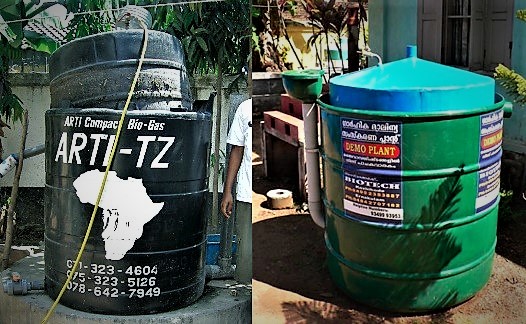
The BIOTECH plants
BIOTECH is a nodal agency of the Ministry of Non-Conventional Energy Sources in Kerala, South India (MUELLER 2007). BIOTECH has been developing and installing biogas plants that generate biogas from domestic biodegradable waste like cooked food waste, vegetable waste and waste water from kitchen (1 m3 for a 3 to 5 member family meets about 50 % of cooking needs, MUELLER 2007) (see picture above). BIOTECH has also developed reactors for the decentralised anaerobic digestion of organic market waste or municipal solid or slaughterhouse waste. The electricity generated from the decentralized plants for market wastes is used for street lightning and distributed to households.
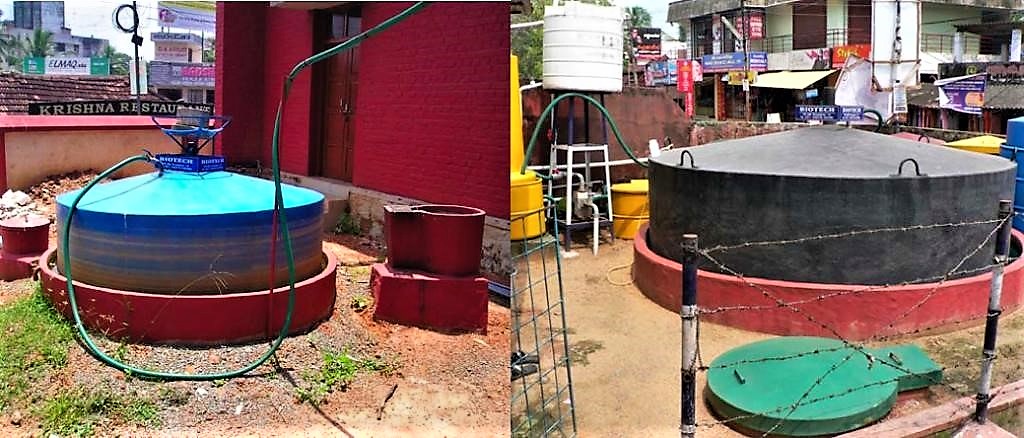
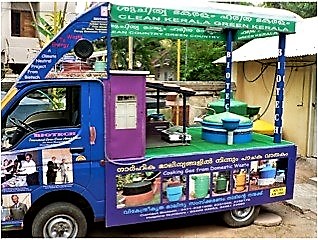
As the ARTIs, the BIOTECH market level plants are based on a floating-drum design including a recirculation loop to optimise moisture content (HEEB 2009). The feedstock (often market wastes) is put in the inlet tank from where it is flushed into the main digester tank for anaerobic digestion (3 m diameter and 3 m depth, HEEB 2009). To increase the retention time for solids, there is a baffle in the middle of the tank and orthogonal to the flow direction. The baffle holds back unsuspended solid compounds of the waste, whereas liquids can easily flow over (much like septic tanks or biogas digesters, see also factsheet (see also small scale digesters or biogas settlers). This leads to an increased retention time for unsuspended solids and therefore to an improved decomposition of this compounds. The digested liquor (digestate) flows into the effluent tank from where a pump, run with electricity of the produced biogas, transports it up into an overhead storage tank. From the tank, the digestate is then used to flush the feedstock from the inlet tank into the digester tank avoiding the need of fresh water for flushing (HEEB 2009).
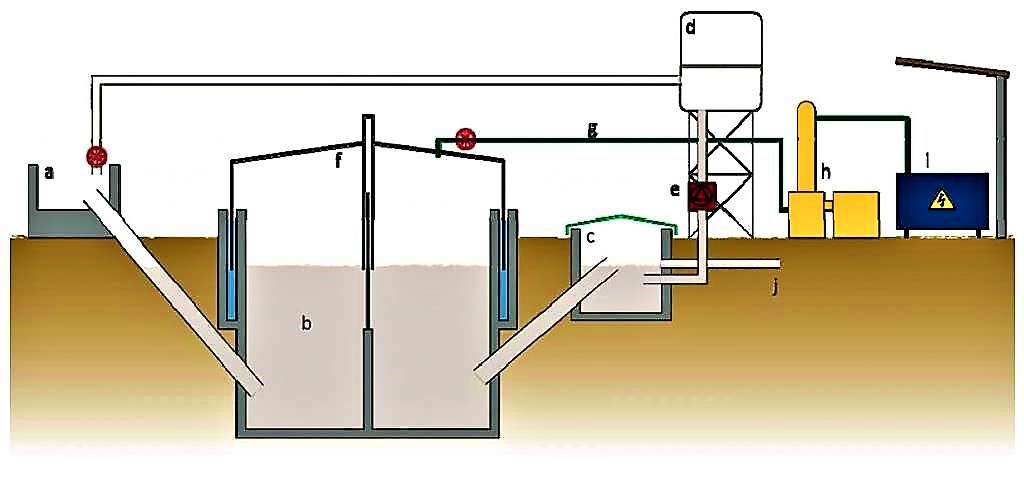
The KOMPOGAS compact
KOMPOGAS is a high-solid thermophilic dry digestion process developed in Switzerland (see also anaerobic treatment of waste and wastewaters). It is a compact plant consisting of a horizontal functioning as plug-flow reactor (PFR). The reactors are fed regularly, mostly every day. Most of the feedstock for KOMPOGAS plants comes from municipalities that support source-separated collection of organic wastes or from the food industry. Before the waste is filled into the reactor, ferrous and plastic materials are removed, it is mixed, and it is sent through a grinder (OSTREM 2004).
Slowly rotating intermittent propellers push the waste through the digester, having also the effect of homogenising and degasing the pulp and of keeping heavier particles in suspension (OSTREM 2004). The retention time is of approximately 20 days (MES et al. 2003). The digested material is then dewatered; some of the press water is being recirculated to the reactor to provide an inoculum and to maintain optimal moisture conditions. The excess liquid is sold as liquid fertiliser. The solid fraction is composted (3 to 4 weeks) and sold as soil amendment. The produced biogas is generally transformed in a CHP unit providing 100 % of the facility needs as well as additional electricity for sale. In some cases, the biogas is upgraded to natural gas standards for use in vehicles or input to the natural gas network (OSTREM 2004). Due to the mechanical requirements of the system, the size of the reactors is limited. To enhance capacity an additional reactors need to be installed in parallel (OSTREM 2004).
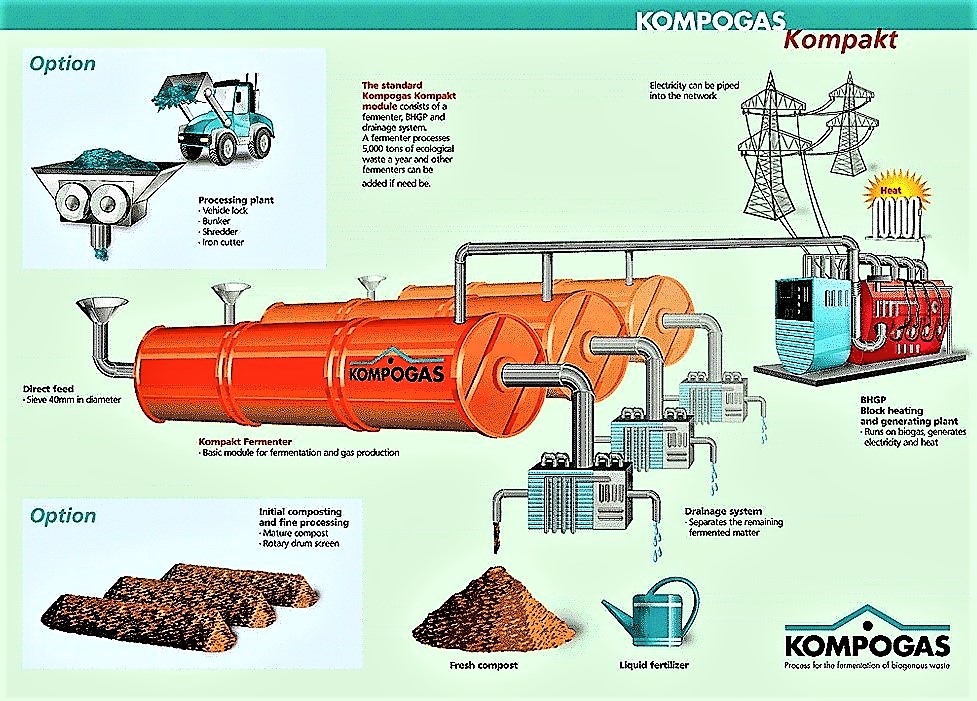
Large-scale wet digestion of municipal organic waste
In Thailand, the development of alternative energy sources is critical, as the government has set 2011 as the target date for 8% of the nation’s total energy reduction (MUELLER 2007). This has given large rise to various large-scale biogas projects. The Rayong Municipality has constructed a wet fed-batch high-solids plant for the treatment of the organic fraction of the municipal solid waste.
The plant is comprised of two systems; a process that converts waste to biogas and fertiliser and a biogas-fired cogeneration process (CHP). Additional to the organic solid waste from the municipality, the Rayong plant uses food, vegetables and fruit wastes and night soil as waste materials. The plant has a capacity to handle 60 tons of waste per day turning out into an output of 5800 tons organic fertiliser and electricity of about 5 million kWh (MUELLER 2007).
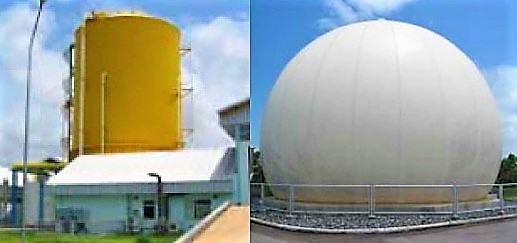
The anaerobic treatment of organic solid waste is particularly adapted where there is a need for a renewable energy, be it at small, institutional (e.g. market) or municipal (large-scale) level. Many types of large-scale reactors exist, in particular high-tech models in industrialized countries. These plants have been largely improved and generally function well, producing more electricity than they require. However, for large-scale high-tech plants, planning, construction, operation and maintenance require a large team of well-skilled experts.
In recent years, small- and institutional-scale organic solid waste digesters have been developed and are continuously improved also in developing countries. Such plants also need expert design and a good understanding of the process, operation and maintenance. However, they can be constructed at relatively low-cost with locally available material in both urban and rural areas.
As every anaerobic digestion process, these plants require relatively high process temperature. Large-scale and complex installations are generally heated. Although small-scale digesters can be heated using their proper biogas, the low-tech designs are generally restricted to tropical and sub-tropical areas.
Biogas Technology - A Training Manual for Extension
This manual contains a complete set of training materials on various topics around the large-scale dissemination of domestic (agricultural) biogas systems, including a system approach to biogas technology, biogas programmes, reuse of slurry, subsidy and institutional financing, quality standards and monitoring and evaluation issues.
FAO (1996): Biogas Technology - A Training Manual for Extension. Support for Development of National Biogas Programme (FAO/TCP/NEP/4451-T) . Consolidated Management Services Nepal (P) Ltd. and Food and Agriculture Organization of the United Nations (FAO) URL [Accessed: 19.04.2010]Technology Review of Biogas Sanitation
This document provides an overview and introduction on biogas sanitation (anaerobic digestion) for blackwater or for brown water, or excreta treatment for reuse in developing countries. The main technologies discussed are biogas settlers (BSs), biogas septic tanks, anaerobic baffled reactor (ABRs), anaerobic filter (AFs) and upflow anaerobic sludge blanket reactors (UASBs).
MANG, H.-P. LI, Z. (2010): Technology Review of Biogas Sanitation. (= Technology Review ). Eschborn: Deutsche Gesellschaft für Internationale Zusammenarbeit (GIZ) GmbH URL [Accessed: 26.05.2019]Decentralised anaerobic digestion of market waste. Case study in Thiruvananthapuram, India
Decentralized anaerobic digestion is a promising technology to handle the large organic fraction of the municipal solid waste with the additional benefit of producing biogas as well as fertilizer. In this study a market level biogas plant in Thiruvananthapuram, South India and constructed by a NGO called BIOTECH is monitored and evaluated.
HEEB, F. (2009): Decentralised anaerobic digestion of market waste. Case study in Thiruvananthapuram, India. Duebendorf: Swiss Federal Institute of Aquatic Science and Technology (EAWAG) URL [Accessed: 31.05.2019]Microbiologie et Biotechnologie Environnementale. Enseignements au 2iE
Biogas Basics
The information service on biogas technology has been developed and produced on the behalf of the GTZ project Information and Advisory Service on Appropriate Technology (ISAT). Volume I tells you all you need to get an overview on biogas sanitation systems, from history over process and operation parameters to social, political and cultural issues.
ISAT ; GTZ (1999): Biogas Basics. (= Biogas Digest , 1 ). Information and Advisory Services on Appropriate Technology (ISAT) and German Agency for Technical Cooperation GmbH (GTZ) URL [Accessed: 03.06.2019]Sustainable Wastewater Management in Urban Areas
A document about sustainable wastewater management in urban areas.
JENSSEN, P.D. GREATOREX, J.M. WARNER, W. S. (2004): Sustainable Wastewater Management in Urban Areas. (= Kapitel 4. Kurs WH33, Konzeptionen dezentralisierter Abwasserreinigung und Stoffstrommanagement ). Hannover: University of HannoverResearch on Anaerobic Digestion of Organic Solid Waste at Household Level in Dar es Salaam, Tanzania
Decentralized anaerobic digestion is a promising technology to handle the large organic fraction of the municipal solid waste (e.g. kitchen waste) with the additional benefit of producing biogas as well as fertilizer. This paper evaluates the suitability of the ARTI Compact biogas system as a decentralised low-tech treatment option for the organic fraction of household waste in Dar es Salaam, Tanzania.
LOHRI (2009): Research on Anaerobic Digestion of Organic Solid Waste at Household Level in Dar es Salaam, Tanzania. (= Bachelor Thesis ). Zurich University of Applied Sciences (ZHAW) URL [Accessed: 27.05.2019]Anaerobic Digestion of Biodegradable Solid Waste in Low- and Middle-Income Countries
Overview of anaerobic treatment options for sustainable sanitation systems
PDF presentation about condominium-level biogas digesters for the transformation of human faeces. Biogas basics as well as two case studies (from Germany and India) are presented.
MUENCH, E. (2008): Overview of anaerobic treatment options for sustainable sanitation systems. In: BGR Symposium "Coupling Sustainable Sanitation and Groundwater Protection": URL [Accessed: 05.06.2019]Greening Waste: Anaerobic Digestion for treating the organic Fraction of Municipal Solid Wastes
This paper outlines the processes of anaerobic digestion, reviews the current technology available for the anaerobic digestion of municipal organic wastes and proposes the adoption of the technology in the United States, beginning with commercial waste in New York City. The greatest concerns for New York are space and transportation, indicating that the most appropriate system is one using solid waste near the site of waste generation. A demonstration plant was constructed to show the improvement of local environmental conditions, job creation, and electricity generation in order to achieve support at policy level.
OSTREM, K. (2004): Greening Waste: Anaerobic Digestion for treating the organic Fraction of Municipal Solid Wastes. (= Master thesis ). Colombia: The Fu Foundation of School of Engineering and Applied Science, Columbia UniversityTypes of anaerobic digesters for solid wastes
This chapter presents and explains most common anaerobic digesters for solid waste. The different technologies are compared in respect to biological and technical performance as well as reliability. It was distinguished between one-stage, two-stage, and batch systems.
VANDEVIVERE, P. BAERE, L. de (2002): Types of anaerobic digesters for solid wastes. In: MATA-ALVAREZ, J. (1999): Biomethanization of the Organic Fraction of Municipal Solid Wastes. London: 336 - 367. URL [Accessed: 06.06.2019]Renewable Energy from Kitchen Waste
This article talks about new treatment options for the anaerobic digestion of organic household waste in developing countries to improve waste management and provide households and institutions with biogas — a renewable, clean source of cooking energy.
VOEGELI, Y. ; LOHRI, C. (2009): Renewable Energy from Kitchen Waste. In: Sandec News: Volume 10 URL [Accessed: 06.06.2019]Decentralised Anaerobic Digestion of Kitchen and Market Waste in Developing Countries - "State-of-the-art" in South India
This paper presents the state-of-the-art of biogas technology in India with particular emphasis on the treatment of kitchen and market waste.
VOEGELI, Y. ; ZURBRUEGG, C. (2008): Decentralised Anaerobic Digestion of Kitchen and Market Waste in Developing Countries - "State-of-the-art" in South India. In: Proceedings Venice 2008, Second International Symposium on Energy from Biomass and Waste, Venice, Italy; 17-20 November 2008: URL [Accessed: 06.06.2019]Technical and biological Performance of the ARTI Compact Biogas Plant for Kitchen Waste - Case Study from Tanzania
With the growing problem of municipal solid waste and the demand for an alternative energy source regarding rising petrol prices, anaerobic digestion technology has also been extended to organic solid wastes instead of animal dung and faecal wastes. This paper evaluates the suitability of a small-scale biogas system as a decentralised treatment option for the organic fraction of market and household solid waste in Dar el Salaam, Tanzania.
VOEGELI, Y. ; LOHRI, C. ; KASSENGA, G. ; BAIER, U. ; ZURBRUEGG, C. (2009): Technical and biological Performance of the ARTI Compact Biogas Plant for Kitchen Waste - Case Study from Tanzania. In: Proceedings Sardinia 2009, Twelfth International Waste Management and Landfill Symposium S. Margherita di Pula, Cagliari, Italy; 5 - 9 October 2009. Environmental Sanitary Engineering Centre (CISA): URL [Accessed: 06.06.2019]Biogas Plants in Animal Husbandry
This guide addresses the planners and providers of stock-farming and agricultural-extension services in developing countries. It is intended to serve as a source of information on the potentials of and prerequisites for biogas technology: a decision-making and planning aid for the construction and dissemination of biogas plants: a book of reference for information on practical experience and detailed data.
WERNER, U. STOEHR, U. HEES., N. (1989): Biogas Plants in Animal Husbandry. German Appropriate Technology Exchange (GATE) and German Agency for Technical Cooperation (GTZ) GmbHDocument 8, Data Management Document, Appendix S 06 - Energy Research
This document provided by Waste Refinery Australia Project Association Inc. contains information on biogas, different types of cogeneration (CHP) and district heating. Additionally there are also facts and information on hydronics and gas flare.
WRAPAI (2009): Document 8, Data Management Document, Appendix S 06 - Energy Research. Australia: Waste Refinery Australia Project Association Incorporated (WRAPAI)The Development and Use of Biogas Technology in Rural Areas of Asia (A Status Report 1981). Improving Soil Fertility through Organic Recycling
Organic Waste. Options for small-scale resource recovery
This book is the first in a series on Urban Solid Waste Recovery, and represents an attempt to document the experiences of recycling activities in cities around the world. It covers the whole waste chain from municipal or agricultural generation of organic waste to different treatment methods, such as composting, co-composting, anaerobic digestion with production of biogas, and briquetting.
LARDINOIS, I. KLUNDERT v.d., A. (1993): Organic Waste. Options for small-scale resource recovery. (= Urban Solid Waste Series 1 ). Gouda: WASTE ConsultantsBiomethane and Biohydrogen. Status and perspectives of biological methane and hydrogen production
Types of anaerobic digesters for solid wastes
This chapter presents and explains most common anaerobic digesters for solid waste. The different technologies are compared in respect to biological and technical performance as well as reliability. It was distinguished between one-stage, two-stage, and batch systems.
VANDEVIVERE, P. BAERE, L. de (2002): Types of anaerobic digesters for solid wastes. In: MATA-ALVAREZ, J. (1999): Biomethanization of the Organic Fraction of Municipal Solid Wastes. London: 336 - 367. URL [Accessed: 06.06.2019]Renewable Energy from Kitchen Waste
This article talks about new treatment options for the anaerobic digestion of organic household waste in developing countries to improve waste management and provide households and institutions with biogas — a renewable, clean source of cooking energy.
VOEGELI, Y. ; LOHRI, C. (2009): Renewable Energy from Kitchen Waste. In: Sandec News: Volume 10 URL [Accessed: 06.06.2019]Biogas in cities - A New Trend?
This paper investigates whether anaerobic digestion could also be suitable to treat organic household waste in urban and peri-urban areas to alleviate the she solid waste crisis in cities of the developing world.
VOEGELI, Y. ; ZURBRUEGG, C. (2008): Biogas in cities - A New Trend?. In: Sandec News: Volume 9Decentralised Anaerobic Digestion of Kitchen and Market Waste in Developing Countries - "State-of-the-art" in South India
This paper presents the state-of-the-art of biogas technology in India with particular emphasis on the treatment of kitchen and market waste.
VOEGELI, Y. ; ZURBRUEGG, C. (2008): Decentralised Anaerobic Digestion of Kitchen and Market Waste in Developing Countries - "State-of-the-art" in South India. In: Proceedings Venice 2008, Second International Symposium on Energy from Biomass and Waste, Venice, Italy; 17-20 November 2008: URL [Accessed: 06.06.2019]Biogas Production in Climates with long cold Winters
This study analyses the feasibility and potential production of biogas in countries with a cold climate, with emphasis on Romania, Kyrgyzstan, Georgia, Kazakhstan and Armenia. The results are compared with China, Nepal and Bolivia. The study also carefully reviews existing literature before suggesting the same technology for the colder target communities. It also contains recommendations on whether to use the plants on household or community level afterwards.
BALASUBRAMANIYAM, U. ZISENGWE, L.S. MERIGGI, N. BUYSMAN, E. (2008): Biogas Production in Climates with long cold Winters. Wageningen: Wageningen University URL [Accessed: 31.05.2019]Dairy Waste Anaerobic Digestion Handbook. Options for Recovering Beneficial Products from Dairy Manure
This manual provides an introduction to the anaerobic digestion of dairy manure. The operation and waste management practices of Idaho dairies, the anaerobic digestion and the anaerobic digestion processes suitable for dairy waste, the typical design applications for different types of dairies and finally the cost and benefits of the facilities are discussed.
BURKE, P.E. Dennis, A. (2001): Dairy Waste Anaerobic Digestion Handbook. Options for Recovering Beneficial Products from Dairy Manure. Olympia: Environmental Energy CompanyAnaerobic Versus Aerobic Treatment in the USA
This study evaluated the feasibility of using anaerobic pre-treatment before aerobic polishing treatment for high-strength industrial wastewater (BOD values ranging form 200 to 5000 mg/L). The results indicated an economic feasibility at water strengths above 1000 mg/L, but treatability evaluation would be required for every specific industrial wastewater to confirm the technical feasibility.
ECKENFELDER, W.W. ; PATOZKA, J.B. ; PULLIAM, G.W. (1988): Anaerobic Versus Aerobic Treatment in the USA. In: Proceedings of the 5th International Symposium of Anaerobic Digestion: , 105-114 . URL [Accessed: 05.08.2010]Dry fermentation biogas technology – a practical approach for closed loop sanitation, waste stabilisation and nutrient recovery
This paper shows, how ‘dry fermentation’ (in opposition to ‘wet fermentation’ of agricultural and communal bio-waste as well as sewage sludge) can produce methane from solid biomass in a mixture of night soil collected from dry toilet systems. The one-staged batch process needs no mixing of biomass during fermentation and no adding of water or liquid compounds, as it is necessary in conventional wet fermentation systems. This system is particularly suitable for application in semiarid climates, as the water consumption in the process is very low compared to conventional anaerobic digestion systems and can be recovered from the ecological sanitation system.
KOETTNER, M. ; KAISER, A. ; AVENDANO, M.V. (2003): Dry fermentation biogas technology – a practical approach for closed loop sanitation, waste stabilisation and nutrient recovery. In: Proceeding of the 2nd international symposium on ecological sanitation. 7th-11th April, Luebeck, Germany: , 483 – 490.Marketing Compost. A Guide for Compost Producers in Low and Middle-Income Countries
This guide describes a marketing approach to composting, and is intended to help compost producers run more viable initiatives by unlocking the value of their product. The handbook does not cover everything there is to know about marketing, but starts with the basics and introduces the key principles and techniques. These include understanding the ‘marketing environment’, identifying appropriate target customer groups, and developing and promoting products to suit the market.
ROUSE ROTHENBERGER, S. ZURBRUEGG, C. (2008): Marketing Compost. A Guide for Compost Producers in Low and Middle-Income Countries. Duebendorf: Water and Sanitation in Developing Countries (SANDEC), Swiss Federal Institute for Environmental Science (EAWAG) URL [Accessed: 27.05.2019]Dry anaerobic digestion of organic residues on-farm – a feasibility study
This study aimed at finding out whether there are economical and ecological advantages of on-farm dry digestion biogas plants over conventional slurry-based technologies. It concludes, that there are no advantages, unless only energy production is considered. An overview of existing technical solutions of farm-scale dry digestion plants is also given.
SCHAEFER, W. LETHO, M. TEYE, F. (2006): Dry anaerobic digestion of organic residues on-farm – a feasibility study. (= Agridfood Research Reports , 77 ). Jokioinen: MTT (Agrifood Research Finland)Document 8, Data Management Document, Appendix S 06 - Energy Research
This document provided by Waste Refinery Australia Project Association Inc. contains information on biogas, different types of cogeneration (CHP) and district heating. Additionally there are also facts and information on hydronics and gas flare.
WRAPAI (2009): Document 8, Data Management Document, Appendix S 06 - Energy Research. Australia: Waste Refinery Australia Project Association Incorporated (WRAPAI)Organic Waste Recycling
This book covers the principles and practices of technologies for the control of pollution originating from organic wastes (e.g. human faeces and urine, wastewater, solid wastes, animal manure and agro-industrial wastes) and the recycling of these organic wastes into valuable products such as fertilizer, biofuels, algal and fish protein and irrigated crops.
POLPRASERT, C. (2007): Organic Waste Recycling. Technology and Management. Bangkok, Thailand: Asian Institute of Technology URL [Accessed: 06.06.2019]Decentralised anaerobic digestion of market waste. Case study in Thiruvananthapuram, India
Decentralized anaerobic digestion is a promising technology to handle the large organic fraction of the municipal solid waste with the additional benefit of producing biogas as well as fertilizer. In this study a market level biogas plant in Thiruvananthapuram, South India and constructed by a NGO called BIOTECH is monitored and evaluated.
HEEB, F. (2009): Decentralised anaerobic digestion of market waste. Case study in Thiruvananthapuram, India. Duebendorf: Swiss Federal Institute of Aquatic Science and Technology (EAWAG) URL [Accessed: 31.05.2019]Research on Anaerobic Digestion of Organic Solid Waste at Household Level in Dar es Salaam, Tanzania
Decentralized anaerobic digestion is a promising technology to handle the large organic fraction of the municipal solid waste (e.g. kitchen waste) with the additional benefit of producing biogas as well as fertilizer. This paper evaluates the suitability of the ARTI Compact biogas system as a decentralised low-tech treatment option for the organic fraction of household waste in Dar es Salaam, Tanzania.
LOHRI (2009): Research on Anaerobic Digestion of Organic Solid Waste at Household Level in Dar es Salaam, Tanzania. (= Bachelor Thesis ). Zurich University of Applied Sciences (ZHAW) URL [Accessed: 27.05.2019]Anaerobic Digestion of Biodegradable Solid Waste in Low- and Middle-Income Countries
Green Energy from Wastes
Compilation of case studies of anaerobic treatment and biogas production at industrial scale. Examples from different industries such as the leather industry, meat and dairy industry and the pulp and paper industry are presented. The treatment of high-strength municipal wastewater/sewage and wastes from vegetable markets are also illustrated.
UNDP (2006): Green Energy from Wastes. Ministry of non-conventional Energy Sources, Government of India and United Nations Development Programme (UNDP)Technical and biological Performance of the ARTI Compact Biogas Plant for Kitchen Waste - Case Study from Tanzania
With the growing problem of municipal solid waste and the demand for an alternative energy source regarding rising petrol prices, anaerobic digestion technology has also been extended to organic solid wastes instead of animal dung and faecal wastes. This paper evaluates the suitability of a small-scale biogas system as a decentralised treatment option for the organic fraction of market and household solid waste in Dar el Salaam, Tanzania.
VOEGELI, Y. ; LOHRI, C. ; KASSENGA, G. ; BAIER, U. ; ZURBRUEGG, C. (2009): Technical and biological Performance of the ARTI Compact Biogas Plant for Kitchen Waste - Case Study from Tanzania. In: Proceedings Sardinia 2009, Twelfth International Waste Management and Landfill Symposium S. Margherita di Pula, Cagliari, Italy; 5 - 9 October 2009. Environmental Sanitary Engineering Centre (CISA): URL [Accessed: 06.06.2019]Ontario Large Herd Operators European Anaerobic Digestion Tour Report
Biogas - Country Reports
The information service on biogas technology has been developed and produced on the behalf of the GTZ project Information and Advisory Service on Appropriate Technology (ISAT). Volume IV summarises over 20 case studies from biogas sanitation as an appropriate technology in developing countries.
ISAT ; GTZ (1999): Biogas - Country Reports. (= Biogas Digest , 4 ). Information and Advisory Services on Appropriate Technology (ISAT) and German Agency for Technical Cooperation GmbH (GTZ). [Accessed: 19.04.2010] PDFAnaerobic Digestion of Biowaste in Developing Countries
This book published by Eawag/Sandec compiles existing and recently generated knowledge on anaerobic digestion of urban biowaste at small and medium scale with special consideration given to the conditions prevailing in developing countries. Written for actors working in the waste and renewable energy sector, the book is divided into two parts: Part 1 focuses on practical information related to the anaerobic digestion supply chain (substrate-, process-, and product chain), and Part 2 presents selected case studies from around the world.
VOEGELI, Y. LOHRI, C.R. GALLARDO, A. DIENER, S. ZURBRUEGG, C. EAWAG (2014): Anaerobic Digestion of Biowaste in Developing Countries. Practical Information and Case Studies. Duebendorf: Swiss Federal Institute of Aquatic Science and Technology (Eawag) URL [Accessed: 28.05.2019]Biogas Technology - A Training Manual for Extension
This manual contains a complete set of training materials on various topics around the large-scale dissemination of domestic (agricultural) biogas systems, including a system approach to biogas technology, biogas programmes, reuse of slurry, subsidy and institutional financing, quality standards and monitoring and evaluation issues.
FAO (1996): Biogas Technology - A Training Manual for Extension. Support for Development of National Biogas Programme (FAO/TCP/NEP/4451-T) . Consolidated Management Services Nepal (P) Ltd. and Food and Agriculture Organization of the United Nations (FAO) URL [Accessed: 19.04.2010]Organic Waste. Options for small-scale resource recovery
This book is the first in a series on Urban Solid Waste Recovery, and represents an attempt to document the experiences of recycling activities in cities around the world. It covers the whole waste chain from municipal or agricultural generation of organic waste to different treatment methods, such as composting, co-composting, anaerobic digestion with production of biogas, and briquetting.
LARDINOIS, I. KLUNDERT v.d., A. (1993): Organic Waste. Options for small-scale resource recovery. (= Urban Solid Waste Series 1 ). Gouda: WASTE ConsultantsChapter 4. Methane production by anaerobic digestion of wastewater and solid wastes
This chapter is part of a publication, commissioned by the Netherlands Agency for Energy and the Environment (Novem) on the status and perspectives of research and development in the field of high-tech biological production of methane and hydrogen. Chapter 4 gives a short but precise introduction the technological aspects of waste treatment by anaerobic digestion and the reuse of the produced biogas.
MES, T.Z.D. de STAMS, A.J.M. ZEEMAN, G. (2003): Chapter 4. Methane production by anaerobic digestion of wastewater and solid wastes. In: REITH, J.H. ; WIJFFELS, R.H. ; BARTEN, H. (2003): Biomethane and Biohydrogen. Status and perspectives of biological methane and hydrogen production. 58-94.Greening Waste: Anaerobic Digestion for treating the organic Fraction of Municipal Solid Wastes
This paper outlines the processes of anaerobic digestion, reviews the current technology available for the anaerobic digestion of municipal organic wastes and proposes the adoption of the technology in the United States, beginning with commercial waste in New York City. The greatest concerns for New York are space and transportation, indicating that the most appropriate system is one using solid waste near the site of waste generation. A demonstration plant was constructed to show the improvement of local environmental conditions, job creation, and electricity generation in order to achieve support at policy level.
OSTREM, K. (2004): Greening Waste: Anaerobic Digestion for treating the organic Fraction of Municipal Solid Wastes. (= Master thesis ). Colombia: The Fu Foundation of School of Engineering and Applied Science, Columbia UniversityBiogas Basics
The information service on biogas technology has been developed and produced on the behalf of the GTZ project Information and Advisory Service on Appropriate Technology (ISAT). Volume I tells you all you need to get an overview on biogas sanitation systems, from history over process and operation parameters to social, political and cultural issues.
ISAT ; GTZ (1999): Biogas Basics. (= Biogas Digest , 1 ). Information and Advisory Services on Appropriate Technology (ISAT) and German Agency for Technical Cooperation GmbH (GTZ) URL [Accessed: 03.06.2019]Biogas - Costs and Benefits and Biogas – Programme Implementation
This information service on biogas technology has been developed and produced on the order of the GTZ project Information and Advisory Service on Appropriate Technology (ISAT). Volume III discusses the micro- and macro-economic viability of biogas sanitation systems.
ISAT ; GTZ (1999): Biogas - Costs and Benefits and Biogas – Programme Implementation. (= Biogas Digest , 3 ). Information and Advisory Services on Appropriate Technology (ISAT) and German Agency for Technical Cooperation GmbH (GmbH) URL [Accessed: 26.05.2019]Biogas - Country Reports
The information service on biogas technology has been developed and produced on the behalf of the GTZ project Information and Advisory Service on Appropriate Technology (ISAT). Volume IV summarises over 20 case studies from biogas sanitation as an appropriate technology in developing countries.
ISAT ; GTZ (1999): Biogas - Country Reports. (= Biogas Digest , 4 ). Information and Advisory Services on Appropriate Technology (ISAT) and German Agency for Technical Cooperation GmbH (GTZ). [Accessed: 19.04.2010] PDFAnaerobic Methods of Waste Treatment
This technical factsheet describes the treatment of wastes through anaerobic digestion and biogas production at large-scale in a very comprehensive way. The treatment of different wastes, including sewage sludge, agricultural and industrial wastes or solid municipal wastes, is emphasised.
GATE (2000): Anaerobic Methods of Waste Treatment. Technical Information W2e. Frankfurt (Germany): German Agency for Technical Cooperation GmbH (GTZ) and German Appropriate Technology Exchange (GATE) URL [Accessed: 03.06.2019]Waste? Not
Critical article on conventional end-of-pipe wastewater approaches, introducing some alternatives such as biogas digester, arborloos or the fossa alterna.
TUHUS-DUBROW (2008): Waste? Not. In: The Boston Globe: URL [Accessed: 21.02.2010]Category: Biogas
Appropedia is the site for collaborative approaches to sustainability, poverty reduction and international development. This article is about simple and sustainable biogas production and use.
Waste-to-Energy Plant is Ivory Coast’s First CDM Project
A French carbon dealer (ecosur) has registered a waste-to-energy carbon-offset project in Côte d'Ivoire under the Kyoto Protocol's Clean Development Mechanism. The project is based on the anaerobic digestion of municipal solid waste. It's the first CDM project in the West African Economic and Monetary Union (UEMOA), and one of the few in sub-Saharan Africa outside of South Africa.
Waste-to-Energy Plant is Ivory Coast’s First CDM Project
A French carbon dealer (ecosur) has registered a waste-to-energy carbon-offset project in Côte d'Ivoire under the Kyoto Protocol's Clean Development Mechanism. The project is based on the anaerobic digestion of municipal solid waste. It's the first CDM project in the West African Economic and Monetary Union (UEMOA), and one of the few in sub-Saharan Africa outside of South Africa.
Biogas processes for sustainable development
This review is intended to up-date students, practitioners and consultants concerned with Biogas technologies, and to contribute to bringing biogas systems to a more advanced stage, and thereby to achieve a palpable impact in developing countries. Technical, social, environmental ad economic issues are addressed.
Anaerobic digesters
The webpage of Midwest Rural Energy Council (MREC) provides a wide range of information on implementing small- and mid-scale biogas plantations in order to produce electricity.
Netherlands Development Organisation (SNV) library
The Netherlands Development Organisation (SNV) library hosts an extensive choice of domestic biogas reports from around the world domestic biogas.
Various biogas sanitation photos
This Flickr slideshow shows different low-cost biogas plants from all over the world.
International Seminar on Biogas Technology for Poverty Reduction and Sustainable Development
This webpage presents the proceedings of the International Seminar on Biogas Technology for Poverty Reduction and Sustainable Development, jointly sponsored by the United Nations Economic and Social Commission for Asia and the Pacific (UNESCAP) and the Ministry of Agriculture of China (MOA) (18 to 20 October, 2005, Beijing). Utilisation of household biogas systems and large-scale biogas systems as a means to boost rural economy, while contributing to rural poverty reduction and sustainable development are discussed.

